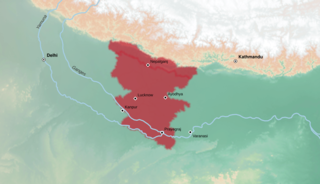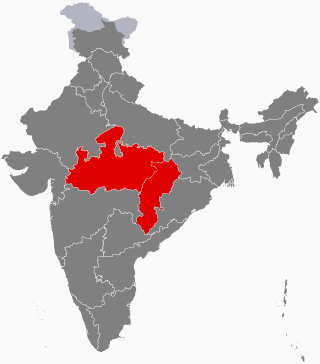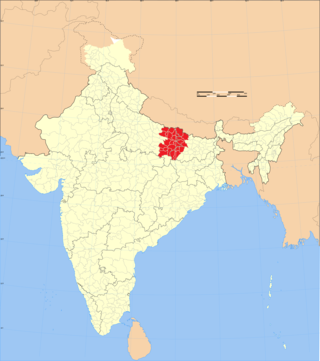
Bhojpuri is an Indo-Aryan language native to the Bhojpur-Purvanchal region of India and the Terai region of Nepal. It is chiefly spoken in eastern Uttar Pradesh, western Bihar and western Jharkhand in India as well as western Madhesh and eastern Lumbini in Nepal. It is an eastern Indo Aryan language and as of 2000 it is spoken by about 5% of India's population. Bhojpuri is a descendant of Magadhi Prakrit and is related to Maithili, Magahi, Bangla, Odia, Assamese, and other eastern Indo-Aryan languages.

Bundeli or Bundelkhandi is an Indo-Aryan language spoken in the Bundelkhand region of central India. It belongs to the Central Indo-Aryan languages and is part of the Western Hindi subgroup.

Bagheli or Baghelkhandi is a Central Indo-Aryan language spoken in the Baghelkhand region of central India.
Chhattisgarhi (छत्तीसगढ़ी) is an Indo-Aryan language spoken by approximately 16.25 million people from Chhattisgarh, Odisha, Madhya Pradesh and Maharashtra in India. It is the official language of Chhattisgarh. It is grouped within the Eastern Hindi languages and is counted by the Indian national census as a dialect of Hindi.

Bagelkhand or Baghelkhand is a proposed state and a mountain range in central India that covers the northeastern regions of Madhya Pradesh and a small area of southeastern Uttar Pradesh.

Awadhi, also known as Audhi, is an Indo-Aryan language spoken in the Awadh region of Uttar Pradesh in northern India and in Terai region of western Nepal. The name Awadh is connected to Ayodhya, the ancient city, which is regarded as the homeland of the Hindu god Rama. It was, along with Braj, used widely as a literary vehicle before being displaced by Hindi in the 19th century.

The Hindi Belt, also known as the Hindi Heartland, is a linguistic region encompassing parts of northern, central, eastern, and western India where various Northern, Central, Eastern and Western Indo-Aryan languages are spoken, which in a broader sense is termed as Hindi languages, with Standard Hindi serving as the lingua franca of the region.
Dramatic Prakrits were those standard forms of Prakrit dialects that were used in dramas and other literature in medieval India. They may have once been spoken languages or were based on spoken languages, but continued to be used as literary languages long after they ceased to be spoken. Dramatic Prakrits are important for the study of the development of Indo-Aryan languages, because their usage in plays and literature is always accompanied by a translation in Sanskrit.

Central India is a loosely defined geographical region of India. There is no clear official definition and various ones may be used. One common definition consists of the states of Chhattisgarh and Madhya Pradesh, which are included in almost all definitions. Like some other definitions this takes the part of northern India that is "central" on an east–west axis. Thus the Central Zonal Council set up by the Indian government includes both these states, plus Uttar Pradesh and Uttarakhand to the north, the last taking the region to the border with Tibet/China in the Himalayas.

Caribbean Hindustani is an Indo-Aryan language spoken by Indo-Caribbeans and the Indo-Caribbean diaspora. It is a koiné language mainly based on the Bhojpuri and Awadhi dialects. These Hindustani dialects were the most spoken dialects by the Indians who came as immigrants to the Caribbean from Colonial India as indentured laborers. It is closely related to Fiji Hindi and the Bhojpuri-Hindustani spoken in Mauritius and South Africa.

Fiji Hindi is an Indo-Aryan language spoken by Indo-Fijians. It is an Eastern Hindi and Bihari language, considered to be a koiné language based on Awadhi that has also been subject to considerable influence by Bhojpuri, other Eastern Hindi and Bihari dialects, and Standard Hindi-Urdu. It has also borrowed some vocabulary from English, Fijian, Telugu, Tamil, Bengali, Punjabi, Gujarati, and Malayalam. Many words unique to Fiji Hindi have been created to cater for the new environment that Indo-Fijians now live in. First-generation Indians in Fiji, who used the language as a lingua franca in Fiji, referred to it as Fiji Baat, "Fiji talk". It is closely related to Caribbean Hindustani and the Bhojpuri-Hindustani spoken in Mauritius and South Africa. It is largely mutually intelligible with the languages of Awadhi and Bhojpuri, as well as with the Bihari languages of Bihar, Uttar Pradesh, Jharkhand, Madhesh, Koshi and Lumbini, and the dialects of Eastern Hindi of Uttar Pradesh, Madhya Pradesh, Chhattisgarh and Lumbini, but differs in phonetics and vocabulary with Modern Standard Hindi and Urdu.

The Western Hindi languages, also known as Midland languages, are a branch of the Indo-Aryan language family spoken chiefly in Haryana, western Uttar Pradesh and Bundelkhand region of Madhya Pradesh, in Northwest and Central India. The Western Hindi languages evolved from Sauraseni Prakrit. The most-spoken language in the Western Hindi language family is Standard Hindi, one of the official languages of the Government of India and one of the 22 Scheduled Languages of India.
The demographics of Uttar Pradesh is a complex topic, which is undergoing dynamic change. Uttar Pradesh is India's most populous state, and the largest subdivision in the world. It has a population of about 199,812,341 as per the 2011 census. If it were a separate country, Uttar Pradesh would be the world's fifth most populous nation, next only to China, the rest of India, the United States of America and Indonesia. Uttar Pradesh has a population more than that of Pakistan. There is an average population density of 828 persons per km2 i.e. 2,146 per sq mi. The capital of Uttar Pradesh is Lucknow, and Prayagraj serves as the state’s judicial capital. Hindus and Muslims both consider the state as a holy place.

The Tharu or Tharuhat languages are any of the Indo-Aryan languages spoken by the Tharu people of the Terai region in Nepal, and neighboring regions of Uttarakhand, Uttar Pradesh and Bihar in India.

Uttar Pradesh is a multilingual state with 3 predominant languages and 26 other languages spoken in the state. The languages of Uttar Pradesh primarily belong to two zones in the Indo-Aryan languages, Central and East.
The Awadhi people or Awadhis are an Indo-Aryan ethno-linguistic group who speak the Awadhi language and reside in the Awadh region of Uttar Pradesh. Many Awadhis also migrated to Madhya Pradesh, Bihar, Jharkhand, Gujarat, Maharashtra, Odisha in India and some adjoining regions of the Terai in Nepal, and in addition 3 per cent of Nepalis are Awadhi speakers. Awadhi people can be found throughout the world, most notably in Fiji, Guyana, Mauritius, South Africa, Suriname, and Trinidad and Tobago. Historically, Indo-Aryans dominated the North Indian Gangetic Planes; thus, the Awadhi language continuously evolved over the centuries in the Awadh region of Uttar Pradesh.

Bhojpur is a ethnolinguistic and cultural area in the Indian subcontinent where the Bhojpuri language is spoken as a mother tongue. The Bhojpuri region encompasses parts of the Indian states of Bihar, Uttar Pradesh, and Jharkhand, and the Madhesh, Gandaki and Lumbini provinces of Nepal.

The Central Indo-Aryan languages or Hindi languages are a group of Indo-Aryan languages spoken across Northern and Central India. These language varieties form the central part of the Indo-Aryan language family, itself a part of the Indo-European language family. They historically form a dialect continuum that descends from the Middle Prakrits. Located in the Hindi Belt, the Central Zone includes the Dehlavi (Delhi) dialect of the Hindustani language, the lingua franca of Northern India that is the basis of the Modern Standard Hindi and Modern Standard Urdu literary standards. In regards to the Indo-Aryan language family, the coherence of this language group depends on the classification being used; here only Eastern and Western Hindi languages will be considered.
Powari is an Indo-Aryan language spoken primarily in Madhya Pradesh and Eastern Maharashtra. It belongs to the Hindi subgroup.
Ardhamagadhi Prakrit was a Middle Indo-Aryan language and a Dramatic Prakrit thought to have been spoken in modern-day Bihar and Uttar Pradesh and used in some early Buddhist and Jain dramas. It was likely a Central Indo-Aryan language, related to Pali and the later Shauraseni Prakrit. The Eastern Hindi languages evolved from Ardhamagadhi Prakrit.














